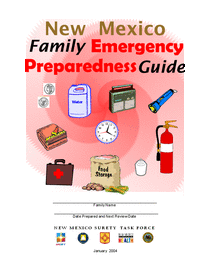Family Emergency Preparedness Guide

Communities throughout the Southwest are subject to a number of potential natural disasters such as fires, tornadoes, flooding, severe storms, earthquakes, dam failures, landslides. While we all hope that such occurrences never happen, it has been shown time and time again that being prepared for disasters is prudent.
Emergency services and government agencies may not be able to respond to your needs immediately. Their buildings, equipment, personnel, communications, and mobility may be severely hampered by the event. Experts tell us to plan to be on our own for a minimum of 3 days. We cannot stop these disasters from occurring, but we can limit their impact on us and those we love.
Contrary to what you may think, the chances of being killed or injured in a disaster are very low. More likely you will be unable to live normally in your home. It may be damaged and let in the weather, it may be cold with no heat, you may have no power or water, or it may not even be safe for you to go back into. In short, disasters make life very uncomfortable.
Proper planning and preparation will help you and your family be more comfortable in the event that your home is damaged, or you can’t get back into it. Think of it as a “quality of life” issue. The most important concept in developing your Family Emergency Preparedness Plan is communication. Every member of the family needs to be involved so that when disaster strikes, everyone will know what to do. How well you manage the aftermath of disaster depends a great deal on your level of preparedness when disaster strikes.
In this guide, you will find a step-by-step guide to disaster planning along with other essential information you will need in building a comprehensive family emergency preparedness plan. Be sure to involve all the members of your household when developing your preparedness plan. A plan will only work when everyone knows about it and agrees to operate within its guidelines. In addition to the items identified in this guide, there may be other items or special needs that you will want to include in your plan, and now is a good time to identify them.
Once your family is prepared, it is time to look to your neighbors. In times of disaster your neighbors will probably be the first ones available to come to your aid. Find out before disaster strikes what resources you share and how you can work together for the good of one another. Good luck! and don’t forget to review your plan bi-annually.
NOTE: The New Mexico Family Emergency Preparedness Guide was jointly developed by the Governor's Office of Homeland Security, New Mexico Surety Task Force, New Mexico Department of Transportation, New Mexico Department of Public Safety, New Mexico Department of Health and the New Mexico Army National Guard. This publication is supported by Grant # EMT-2004-GR-0103 awarded by the Federal Emergency Management Agency (FEMA). This publication does not necessarily reflect FEMA's views.

